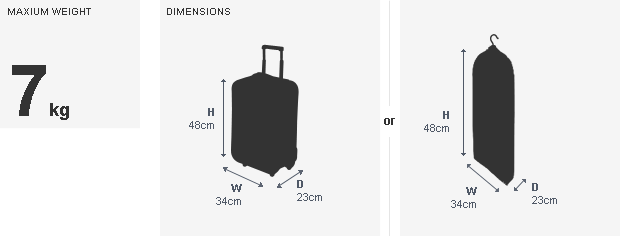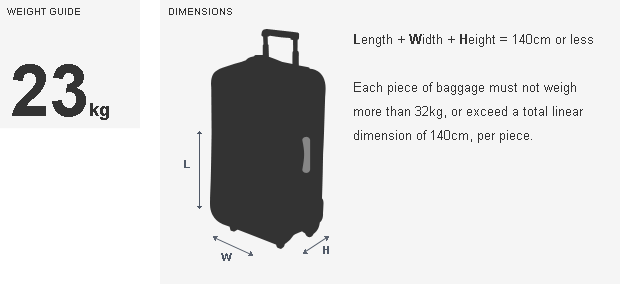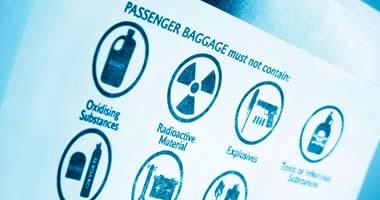Carry On

As a general rule, passengers are allowed to take one bag and one personal item with them onto their flight. As such, there are certain size and weight restrictions to ensure each passenger's belongings can fit in the cabin. Personal items usually include a handbag, briefcase or laptop bag that can fit easily underneath the cabin seat. In addition to a personal item, passengers may be able to bring on an additional bag or suit pack that can fit easily and be lifted by the passenger, into the overhead locker. See above for general dimensions.
Carry-on weight for bags may vary between classes and airlines. As a general guide, Economy Class passengers are allowed to carry one bag at 5kg to 7kg per person while Business and First Class passengers are often privy to a more generous baggage allowance or extra pieces.
![]() Take an extra set of clothing in your carry-on bag in case of the unforseen.
Take an extra set of clothing in your carry-on bag in case of the unforseen.
Checked Baggage

At the time of check-in, passengers have the option to check-in their baggage. For some airlines check-in baggage is included in the price, while other airlines may charge a fee. Similar to carry-on baggage, each airline will also have their own restrictions as to the size and weight of each suitcase. As a general rule suitcases should not exceed a total linear dimension of 140cm (see diagram above) and may weigh between 15kg to 32kg for each piece of luggage in Economy Class and First and Business Class are generally allowed extra pieces. Suitcases that weigh over the limit may be subject to an additional fee. Any excess baggage or additional pieces may be organised prior to travel or at the airport check-in desk. Talk to your airline for further details.
Depending on the airline, class of travel and destination, a baggage piece system where passengers can check in up to 2 or 3 bags may apply. The piece system generally applies to flights to and from North, Central and South America. For specific baggage allowances please refer to our domestic or international airline guide.
![]() Avoid packing any breakables or valuables in your check-in luggage as items may get damaged or lost. Always take your passport, cash, business documents, laptop and medications with you in your carry-on luggage.
Avoid packing any breakables or valuables in your check-in luggage as items may get damaged or lost. Always take your passport, cash, business documents, laptop and medications with you in your carry-on luggage.
Bulky Items

Bulky items such as golf clubs, music equipment, ski equipment or bicycles may be included as part of your checked baggage allowance if there is enough space on the aircraft, or an additional fee may apply. Generally items such as fishing rods, bicycles or surfboards must be packed in an appropriate way that abides by the airlines baggage restrictions. For specific details check with your airline.
![]() When travelling with a bicycle pack it in a travel box, remove the pedals and secure tight as to not damage. Travel boxes are available at most bike shops or through the airline direct.
When travelling with a bicycle pack it in a travel box, remove the pedals and secure tight as to not damage. Travel boxes are available at most bike shops or through the airline direct.
Infant Baggage
Travelling with an infant
Infant baggage guidelines will vary between airlines and sometimes form part of your adult baggage allowance, depending on the airline. Depending on the age of the child, infant passengers may also be permitted to bring a car seat or baby capsule on board. Strollers and collapsible prams are generally allowed to be taken to the boarding gate where they will be checked there. Airlines may also have specific requirements as to the type of car seat in order to ensure the infants safety. For specific infant seat requirements, refer to your airline for correct information.
Though there are restrictions when it comes to carrying liquids onto an aircraft, parents of infants are allowed to carry a certain amount of breast milk, baby formula, juice or baby food for use during the flight. Amounts will vary depending on the destination and airline. Always check with your airline before departure.
![]() Try and travel where possible at regular infant sleep hours and pack plenty of nappies and food to cover any unforseen delays.
Try and travel where possible at regular infant sleep hours and pack plenty of nappies and food to cover any unforseen delays.
Restricted Items
Travelling with restricted or dangerous goods
Items that are restricted from flying are considered to be dangerous goods that could harm the safety of an aircraft and/or its passengers. These items are generally determined by the authorities and are governed accordingly. Some examples of dangerous goods include, but not limited to, flammable liquids, organic peroxides, lithium batteries and explosives. These items are restricted from both carry on and check-in luggage.
Carry-on baggage restrictions are also in place for liquids, aerosols and gels on international flights. While these items can be brought into the cabin, they cannot exceed 100 millilitres and must be packed in a resealable 1 litre or less, clear plastic bag. Exemptions apply to medicines and baby products.
![]() If in doubt, always check with your airline before you leave for the airport so the goods are not confiscated on day of travel.
If in doubt, always check with your airline before you leave for the airport so the goods are not confiscated on day of travel.







